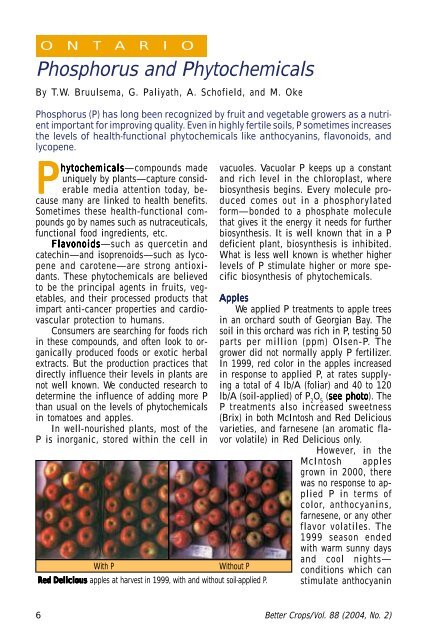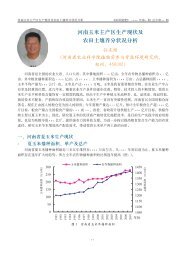Better Crops 2004 #2 - International Plant Nutrition Institute
Better Crops 2004 #2 - International Plant Nutrition Institute
Better Crops 2004 #2 - International Plant Nutrition Institute
You also want an ePaper? Increase the reach of your titles
YUMPU automatically turns print PDFs into web optimized ePapers that Google loves.
O N T A R I O<br />
Phosphorus and Phytochemicals<br />
By T.W. Bruulsema, G. Paliyath, A. Schofield, and M. Oke<br />
Phosphorus (P) has long been recognized by fruit and vegetable growers as a nutrient<br />
important for improving quality. Even in highly fertile soils, P sometimes increases<br />
the levels of health-functional phytochemicals like anthocyanins, flavonoids, and<br />
lycopene.<br />
Phytochemicals<br />
hytochemicals—compounds made vacuoles. Vacuolar P keeps up a constant<br />
uniquely by plants—capture considerable<br />
media attention today, be-<br />
biosynthesis begins. Every molecule pro-<br />
and rich level in the chloroplast, where<br />
cause many are linked to health benefits.<br />
Sometimes these health-functional compounds<br />
go by names such as nutraceuticals,<br />
functional food ingredients, etc.<br />
Flavonoids—such as quercetin and<br />
catechin—and isoprenoids—such as lycopene<br />
and carotene—are strong antioxidants.<br />
These phytochemicals are believed<br />
duced comes out in a phosphorylated<br />
form—bonded to a phosphate molecule<br />
that gives it the energy it needs for further<br />
biosynthesis. It is well known that in a P<br />
deficient plant, biosynthesis is inhibited.<br />
What is less well known is whether higher<br />
levels of P stimulate higher or more specific<br />
biosynthesis of phytochemicals.<br />
to be the principal agents in fruits, vegetables,<br />
and their processed products that<br />
impart anti-cancer properties and cardiovascular<br />
protection to humans.<br />
Consumers are searching for foods rich<br />
in these compounds, and often look to organically<br />
produced foods or exotic herbal<br />
extracts. But the production practices that<br />
directly influence their levels in plants are<br />
not well known. We conducted research to<br />
Apples<br />
We applied P treatments to apple trees<br />
in an orchard south of Georgian Bay. The<br />
soil in this orchard was rich in P, testing 50<br />
parts per million (ppm) Olsen-P. The<br />
grower did not normally apply P fertilizer.<br />
In 1999, red color in the apples increased<br />
in response to applied P, at rates supplying<br />
a total of 4 lb/A (foliar) and 40 to 120<br />
determine the influence of adding more P lb/A (soil-applied) of P 2<br />
O 5<br />
(see photo). The<br />
than usual on the levels of phytochemicals P treatments also increased sweetness<br />
in tomatoes and apples.<br />
In well-nourished plants, most of the<br />
P is inorganic, stored within the cell in<br />
(Brix) in both McIntosh and Red Delicious<br />
varieties, and farnesene (an aromatic flavor<br />
volatile) in Red Delicious only.<br />
However, in the<br />
McIntosh apples<br />
With P<br />
Without P<br />
grown in 2000, there<br />
was no response to applied<br />
P in terms of<br />
color, anthocyanins,<br />
farnesene, or any other<br />
flavor volatiles. The<br />
1999 season ended<br />
with warm sunny days<br />
and cool nights—<br />
conditions which can<br />
Red Delicious apples at harvest in 1999, with and without soil-applied P. stimulate anthocyanin<br />
6 <strong>Better</strong> <strong>Crops</strong>/Vol. 88 (<strong>2004</strong>, No. 2)

















